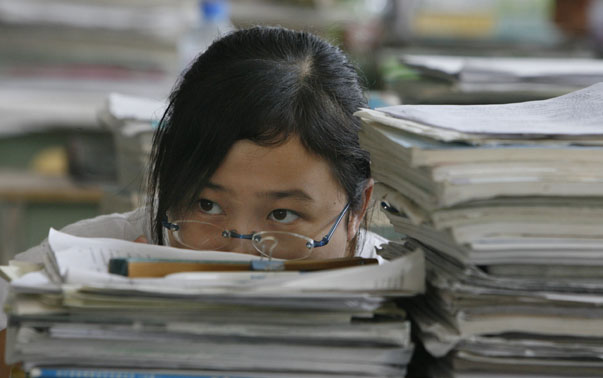UK schoolchildren are still lagging way behind their pen pals in south east Asia, despite an increase in education spending.
That’s according to the OECD’s Programme for International Student Assessment (Pisa) programme, whose latest results made headlines around the world today.
You can sit a Pisa test, like the ones taken by about half a million 15-year-olds around the world every three years, here.
The tests are supposed to show how well pupils apply maths, reading and science skills to real-life situations, cutting through the massive differences in curriculum around the world.
The key finding for the UK – that children have essentially made no progress for the last few years – makes for slightly depressing reading. The political reaction has largely consisted of squabbling over whether all this is the fault of the current government or the last one.
What else do today’s figures reveal – and why should we be worried?

Others have improved
British 15-year-olds performed about average in maths and reading and above average in science. There were no significant changes compared with results in 2006 and 2009.
But other countries, notably the Asian nations at the top of the league tables as well as European countries like Germany and Poland, have managed big improvements over the same timeframe.
Pisa co-ordinator Andreas Schleicher rejects the notion that educational achievement depends on social and cultural factors that are resistant to change, saying: “Poland did not change its culture or the composition of its population, nor did it sack its teachers. It changed the way it runs its education system.”
http://embed.ted.com/talks/andreas_schleicher_use_data_to_build_better_schools.html
Value for money?
Britain’s results are static despite the fact that we spend more than the OECD average on education.
Education spending went from 4.4 per cent to 6.2 per cent of GDP over the 13 years Labour were in power, with no evidence of academic improvement to show for it.
That’s not a surprise to the Pisa researchers, who say: “There is no overall relationship between spending on education and average performance…once a certain level of spending is reached, more resources no longer predict higher achievement.”
Do we really want to be like the Asian countries?
That is a point made by several commentators today, who point to negative effects including declining birth rates in the south east Asian nations who top the Pisa tables, which allegedly stem from an unhealthy fixation on education.
Despite the clustering of Asian nations and regions at the top of the table, countries from very different regions with very different cultures still manage to outperform the UK.
Liechtenstein, Switzerland and our close neighbours in the Netherlands score among the top 10 for maths. Canada, Finland and Estonia score highly across all three subjects.
Can we trust Pisa?
The project has a small number of vociferous critics, whose objections to the statistical methodology are set out in detail here. Mr Schleicher has responded in an article of his own.
The OECD itself states that there is a margin of error in the league tables, suggesting that we shouldn’t get too hung up about whether a country has gone up or down by one or two places.
Some critics don’t like the fact that Pisa offers a regular snapshot of where different groups of 15-year-olds are, rather than following the same cohort of pupils and tracking their outcomes.
Others have expressed doubts about whether the designers have taken sufficient care to iron out the effect of cultural differences. India pulled out of Pisa last year, citing “a socio-cultural disconnect between the questions and Indian students”. It may or may not be a coincidence that the country performed appallingly badly in the previous round of tests.
What do other tests say?
If we don’t like Pisa and we still want to make some kind of international comparison, there really isn’t a lot of data to choose from.
The Trends in International Maths and Science Study (TIMSS) is probably Pisa’s main competitor, and it is a more flattering dataset for British children.
England and Wales is regularly one of the top 10 performing countries for science and has improved its results in maths in recent rounds.
As for reading, England was just outside the top 10 in the last Progress in International Reading Literacy Study, an improvement on its previous performance.
Do the results vindicate Michael Gove’s reforms?
Yes and no. The education secretary clearly takes Pisa seriously, and he will take some comfort from the conclusion that “school systems that grant more autonomy to schools to define and elaborate their curricula and assessments tend to perform better”.
That doesn’t amount to a wholescale vindication of his decision to create unprecendented numbers of academies and free schools, which are supposed to be more autonomous.
Pisa also found that it doesn’t make much difference whether a child goes to a normal school, a free scale or a private school, once you account for his or her socioeconomic background.
Labour were on the attack today over the controversial change last summer when Mr Gove decided to allow academies as well as free schools hire people who do not have Qualified Teacher Status.
But Pisa stats don’t settle the argument about whether having fewer officially qualified teachers is a good thing.
Many of the highest-performing countries have high percentages of certified teachers, and tend to only employ teachers with the equivalent of a degree.
But some countries with very low percentages of teachers who are certified and university graduates – like the Netherlands, Switzerland and Liechtenstein – also do very well in Pisa tests.
By Patrick Worrall




